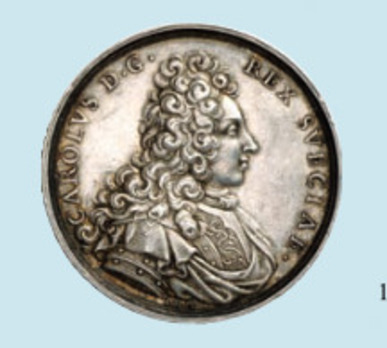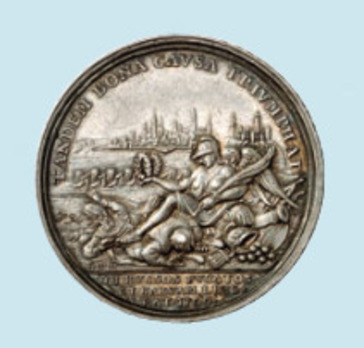The Taking of Narva, Silver Medal
CATEGORY: Version
SKU: 02.RUS.0103.101.01.000
Estimated market value:


Estimated market value:
Medal. Silver. 40.7 mm. 29.59 gm. ByPhilippHeinrichMüller. Battle of Narva,1700. Hildebrand 45. Peruked, draped and cuirassed bust of Karl XII r. / Bare- breasted Svea seated r. atop trophies, her legs draped over vanquished Russian soldiers, city in the background; TANDEM BONA CAVSA TRIVMPHAT (Agood cause triumphs in the end), three-line legend in ex. Lovely old toning
This medal was instituted by Peter the Great in commemoration of the defeat of Narva by the Russian forces. It was conferred upon high-ranking individuals who participated in the capture of the fortress at Narva.
The obverse inscription translates to: "Tsar Peter Alekseevich, Sovereign of All Russia." The reverse inscription translates to: "Conquered. Not With Trickery. But With Arms. With Help. From the Almighty".
The first Battle of Narva took place in 1700, and was a Swedish victory under Charles XII. Shortly after, the swedish turned their attention to expel August the Strong of Saxony out of Livonia and Poland-Lithuania. Tsar Peter the Great took Narva in a second battle in 1704.
The Second Battle of Narva, or the Siege of Narva, occured during the Great Northern War and officially began on June 27, lasting until August 9, 1704. On June 24, the Russian forces of 20,000 captured Tartu and then besieged Narva overpowering the nearly 5,000 Swedish soldiers. The Russians incurred approximately 3,000 men. That August, Peter signed the Treaty of Narva which aligned the Sandomierz Confederation faction of the Polish-Lithuanian Commonwealth with Russia against Sweden. On September 11, the Swedish citizens of Narva swore allegiance to Peter I and the domain was incorporated into the Russian Tsardom.

Comments
Sign in to comment and reply.


Scroll Top